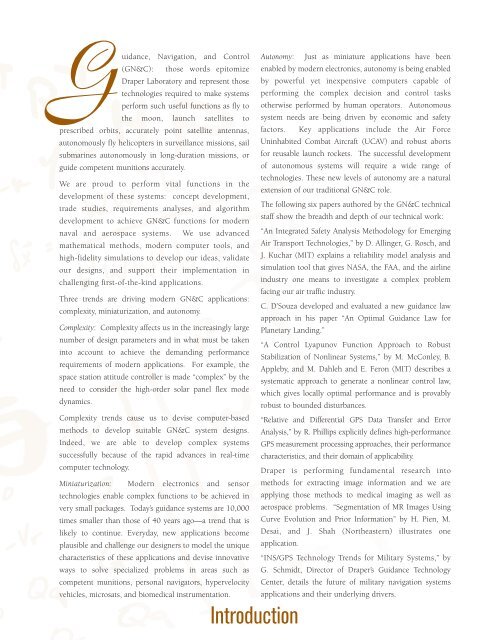1998 - Draper Laboratory
1998 - Draper Laboratory
1998 - Draper Laboratory
- No tags were found...
You also want an ePaper? Increase the reach of your titles
YUMPU automatically turns print PDFs into web optimized ePapers that Google loves.
Guidance, Navigation, and Control Autonomy: Just as miniature applications have been(GN&C): those words epitomize enabled by modern electronics, autonomy is being enabled<strong>Draper</strong> <strong>Laboratory</strong> and represent those by powerful yet inexpensive computers capable oftechnologies required to make systems performing the complex decision and control tasksperform such useful functions as fly to otherwise performed by human operators. Autonomousthe moon, launch satellites to system needs are being driven by economic and safetyprescribed orbits, accurately point satellite antennas, factors. Key applications include the Air Forceautonomously fly helicopters in surveillance missions, sailsubmarines autonomously in long-duration missions, orguide competent munitions accurately.Uninhabited Combat Aircraft (UCAV) and robust abortsfor reusable launch rockets. The successful developmentof autonomous systems will require a wide range oftechnologies. These new levels of autonomy are a naturalWe are proud to perform vital functions in theextension of our traditional GN&C role.development of these systems: concept development,The following six papers authored by the GN&C technicaltrade studies, requirements analyses, and algorithmstaff show the breadth and depth of our technical work:development to achieve GN&C functions for modernnaval and aerospace systems. We use advancedmathematical methods, modern computer tools, andhigh-fidelity simulations to develop our ideas, validateour designs, and support their implementation inchallenging first-of-the-kind applications.“An Integrated Safety Analysis Methodology for EmergingAir Transport Technologies,” by D. Allinger, G. Rosch, andJ. Kuchar (MIT) explains a reliability model analysis andsimulation tool that gives NASA, the FAA, and the airlineindustry one means to investigate a complex problemfacing our air traffic industry.Three trends are driving modern GN&C applications:C. D’Souza developed and evaluated a new guidance lawcomplexity, miniaturization, and autonomy.approach in his paper “An Optimal Guidance Law forComplexity: Complexity affects us in the increasingly large Planetary Landing.”number of design parameters and in what must be taken“A Control Lyapunov Function Approach to Robustinto account to achieve the demanding performanceStabilization of Nonlinear Systems,” by M. McConley, B.requirements of modern applications. For example, theAppleby, and M. Dahleh and E. Feron (MIT) describes aspace station attitude controller is made “complex” by thesystematic approach to generate a nonlinear control law,need to consider the high-order solar panel flex modedynamics.Complexity trends cause us to devise computer-basedmethods to develop suitable GN&C system designs.Indeed, we are able to develop complex systemssuccessfully because of the rapid advances in real-timecomputer technology.which gives locally optimal performance and is provablyrobust to bounded disturbances.“Relative and Differential GPS Data Transfer and ErrorAnalysis,” by R. Phillips explicitly defines high-performanceGPS measurement processing approaches, their performancecharacteristics, and their domain of applicability.<strong>Draper</strong> is performing fundamental research intoMiniaturization: Modern electronics and sensor methods for extracting image information and we aretechnologies enable complex functions to be achieved invery small packages. Today’s guidance systems are 10,000times smaller than those of 40 years ago—a trend that islikely to continue. Everyday, new applications becomeplausible and challenge our designers to model the uniquecharacteristics of these applications and devise innovativeways to solve specialized problems in areas such ascompetent munitions, personal navigators, hypervelocityapplying those methods to medical imaging as well asaerospace problems. “Segmentation of MR Images UsingCurve Evolution and Prior Information” by H. Pien, M.Desai, and J. Shah (Northeastern) illustrates oneapplication.“INS/GPS Technology Trends for Military Systems,” byG. Schmidt, Director of <strong>Draper</strong>’s Guidance TechnologyCenter, details the future of military navigation systemsvehicles, microsats, and biomedical instrumentation.Introductionapplications and their underlying drivers.
















